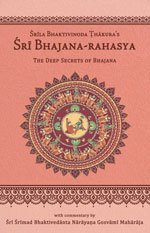Bhajana-Rahasya
by Srila Bhaktivinoda Thakura Mahasaya | 2010 | 123,965 words
The Bhajana-rahasya Text 2, English translation, including commentary (vritti). The Bhajana-rahasya is a compilation of verses describing the mercy of the eight pairs of names (Yugala-nama) of the Maha-mantra. This is text 2 belonging to the chapter “Prathama-yama-sadhana (Nishanta-bhajana–shraddha)” representing the last six dandas of the night: approximately 3.30 a.m.–6.00 a.m.
Text 2
Verse 5 of Śrī Śacīsūnv-aṣṭaka (Stavāvalī) says:
निजत्वे गौडीयान् जगति परिगृह्य प्रभुर् इमान् हरे कृष्णेत्य् एवं गणन-विधिना कीर्तयत भोः
इति प्रायां शिक्षां चरण-मधुपेभ्यः परिदिशन् शची-सूनुः किं मे नयन-सरणीं यास्यति पदम्nijatve gauḍīyān jagati parigṛhya prabhur imān hare kṛṣṇety evaṃ gaṇana-vidhinā kīrtayata bhoḥ
iti prāyāṃ śikṣāṃ caraṇa-madhupebhyaḥ paridiśan śacī-sūnuḥ kiṃ me nayana-saraṇīṃ yāsyati padamWhen will Śacīnandana Śrī Gaurahari appear on the path of my eyes? He accepted as His own the Gauḍīya Vaiṣṇavas in this world, who are like bees at His lotus feet, and He instructed them to chant the Hare Kṛṣṇa mahā-mantra, counting a fixed number of rounds.
Commentary: Bhajana-rahasya-vṛtti:
Here Śrīla Raghunātha dāsa Gosvāmī expresses the natural, affectionate mercy of Śrīman Mahāprabhu for the inhabitants of Gauḍa (Bengal). Their relationship with each other is likened to the affectionate relationship of near and dear ones in this mundane world (laukika-sad-bandhuvat ). This means they have a natural feeling of possessiveness (madīya-bhāva ) towards Śrīman Mahāprabhu, by which they think, “Gaurasundara is ours.” In Śrī Bṛhad-bhāgavatāmṛta, in the section describing rāgamārgabhajana, Śrīla Sanātana Gosvāmī explains that a mood of laukikasad-bandhuvat, which is characterised by intense possessiveness in relation to the Supreme Lord, is indeed the symptom of deep prema for Him.
Although Rasarāja Śrī Kṛṣṇa appeared as Śrī Gaurasundara and gave the process of chanting the Hare Kṛṣṇa mahā-mantra to the entire world, He displayed special compassion toward the inhabitants of Gauḍa. There, in Śrī Navadvīpa-dhāma, is the place renowned as the aparādha-bhañjana, where every kind of offence is vanquished.
Being entirely overwhelmed by bhāva, Śrī Gaurasundara, the originator of saṅkīrtana, would perform kīrtana and dance in the company of the Gauḍīya bhaktas in an unprecedented way. As the sentiments in Śrī Gaurasundara’s heart swelled more and more upon seeing His affectionate devotees, they would, like bees, become intoxicated by drinking the honey-like bliss of prema at His lotus feet.
At the time of saṅkīrtana, Śrī Gaurasundara would dance and sing absorbed in ecstatic bliss as He tasted the sweetness of Kṛṣṇa’s rāsa dance with Śrī Rādhā and the other vraja-gopīs. The wonderful expressions of the spiritual sentiments of this sweet and enchanting dance, which is possessed of transcendental śṛṅgāra-rasa, thus embellished His prema, and He became decorated with the ornaments of the eight extraordinary ecstatic symptoms (aṣṭa-sāttvika-bhāvas ), such as shedding tears and horripilation.
During the festival of Ratha-yātrā in Jagannātha Purī, Śrīman Mahāprabhu’s ecstatic dancing and chanting reached their topmost limit. To support Mahāprabhu’s sentiments, Śrī Svarūpa Dāmodara and Rāya Rāmānanda sang poetry endowed with samṛddhimān sambhogarasa, the ecstatic sentiments experienced by Śrī Rādhā and Śrī Kṛṣṇa when They meet after having been far away from each other. Svarūpa Dāmodara sang, “sei ta’ parāṇa-nātha pāinu, yāhā lāgi’ madanadahane jhuri’ genu–Now I have attained the master of My life. In His absence, I was being burned by Cupid and was withering away.”[1] Hearing this, Śrīman Mahāprabhu would gaze upon Lord Jagannātha’s lotus face. When Their eyes met, Mahāprabhu’s heart would be agitated by waves of ecstasy of divine love, and He would proceed to dance according to the mood of the song. At such times, Śrī Gaurasundara would exhibit extraordinary expressions. He would bite His lips, which were pinkish like the bandhūka flower, artistically place His left hand on His hip, and move His right hand to demonstrate wonderful dance postures that were extremely attractive. This sight would overwhelm Śrī Jagannātha Himself with astonishment and supreme bliss. Tasting the sweetness of the unprecedented beauty of Mahāprabhu’s dance, Śrī Jagannātha would slowly and gently proceed towards Sundarācala (which represents Vṛndāvana).
The brightly shining golden lustre of Śrīman Mahāprabhu’s large body defeated the splendour of a golden mountain. Absorbed in ecstatic bliss, Śrī Gaurasundara loudly chanted His own names, hare kṛṣṇety uccaiḥ sphurita-rasanaḥ[2]. Surrounded by His devotees, Mahāprabhu performed kīrtana, and His restless lotus feet danced. Tears flowed from His eyes like streams of Gaṅgā and Yamunā water, and His bodily hair stood erect in an astonishing way, resembling the filaments of a kadamba flower.
Remembering the unprecedented sweetness of Śrīman Mahāprabhu’s prema, Śrīla Raghunātha dāsa Gosvāmī said, “When will Śacīnandana Śrī Gaurahari appear on the path of my eyes?” As Śrī Dāsa Gosvāmī remembered the great compassion of Mahāprabhu, he became overwhelmed by feelings of separation from Him. He offered this prayer, while continuously shedding tears, waiting for the darśana of his beloved Lord with utmost longing and hope. Then Śrī Gaurasundara’s own compassion, abundant steadfastness, unsurpassed renunciation and fully transcendental prema-bhakti arose in the heart of Dāsa Gosvāmī, who became overwhelmed with ecstatic emotions. He had lived close to Śrī Caitanya Mahāprabhu for a long time and had received unlimited affection, mercy and blessings from Him. The compassion of Śrī Gaurasundara is just like that of a mother. For this reason, Dāsa Gosvāmī addresses Him as Śacīnandana, the son of Mother Śacī. Śacīnandana Śrī Gaurahari bestowed His mercy even upon all kinds of unqualified jīvas, thus making them fortunate.
Footnotes and references:
[2]:
This is Verse 5 of Śrīla Rūpa Gosvāmī’s Prathama-caitanyāṣṭaka (Stavamālā ). It can have two meanings: “His tongue is always dancing by loudly calling out ‘Hare Kṛṣṇa!’” or “the mahā-mantra ecstatically dances of its own accord on the theatrical stage of His tongue”.
